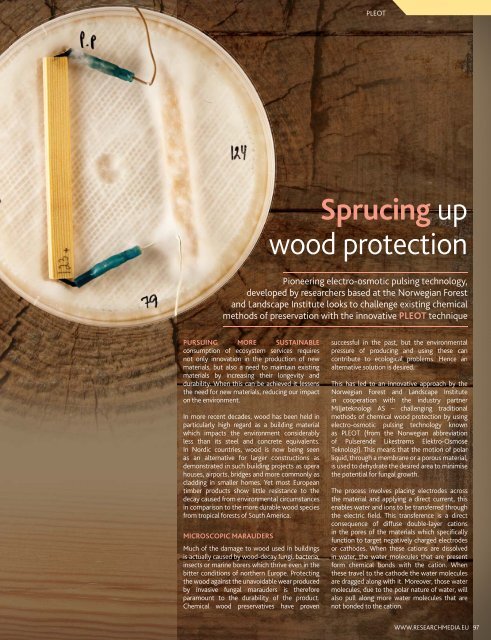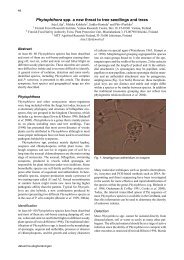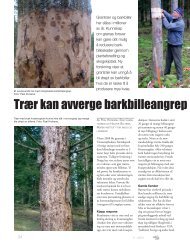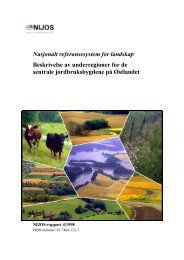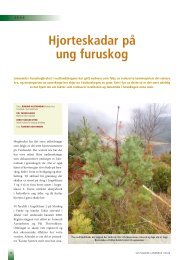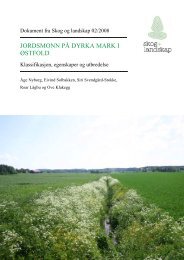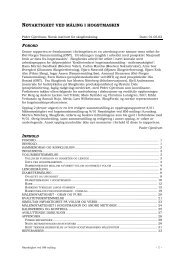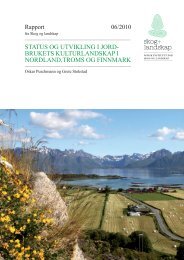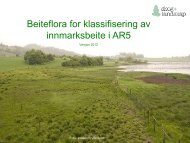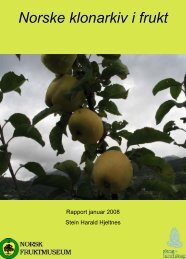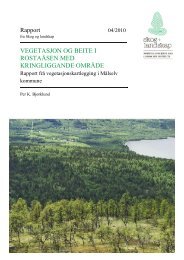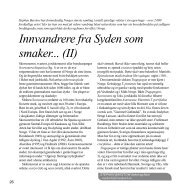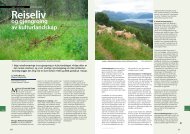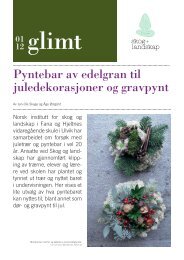Timber technology - Skog og landskap
Timber technology - Skog og landskap
Timber technology - Skog og landskap
Create successful ePaper yourself
Turn your PDF publications into a flip-book with our unique Google optimized e-Paper software.
Sprucing up<br />
wood protection<br />
Pioneering electro-osmotic pulsing <strong>technol<strong>og</strong>y</strong>,<br />
developed by researchers based at the Norwegian Forest<br />
and Landscape Institute looks to challenge existing chemical<br />
methods of preservation with the innovative PLEOT technique<br />
PURSUING MORE SUSTAINABLE<br />
consumption of ecosystem services requires<br />
not only innovation in the production of new<br />
materials, but also a need to maintain existing<br />
materials by increasing their longevity and<br />
durability. When this can be achieved it lessens<br />
the need for new materials, reducing our impact<br />
on the environment.<br />
In more recent decades, wood has been held in<br />
particularly high regard as a building material<br />
which impacts the environment considerably<br />
less than its steel and concrete equivalents.<br />
In Nordic countries, wood is now being seen<br />
as an alternative for larger constructions as<br />
demonstrated in such building projects as opera<br />
houses, airports, bridges and more commonly as<br />
cladding in smaller homes. Yet most European<br />
timber products show little resistance to the<br />
decay caused from environmental circumstances<br />
in comparison to the more durable wood species<br />
from tropical forests of South America.<br />
MICROSCOPIC MARAUDERS<br />
Much of the damage to wood used in buildings<br />
is actually caused by wood-decay fungi, bacteria,<br />
insects or marine borers which thrive even in the<br />
bitter conditions of northern Europe. Protecting<br />
the wood against the unavoidable wear produced<br />
by invasive fungal marauders is therefore<br />
paramount to the durability of the product.<br />
Chemical wood preservatives have proven<br />
PLEOT<br />
successful in the past, but the environmental<br />
pressure of producing and using these can<br />
contribute to ecol<strong>og</strong>ical problems. Hence an<br />
alternative solution is desired.<br />
This has led to an innovative approach by the<br />
Norwegian Forest and Landscape Institute<br />
in cooperation with the industry partner<br />
Miljøteknol<strong>og</strong>i AS – challenging traditional<br />
methods of chemical wood protection by using<br />
electro-osmotic pulsing <strong>technol<strong>og</strong>y</strong> known<br />
as PLEOT (from the Norwegian abbreviation<br />
of Pulserende Likestrøms Elektro-Osmose<br />
Teknol<strong>og</strong>i). This means that the motion of polar<br />
liquid, through a membrane or a porous material,<br />
is used to dehydrate the desired area to minimise<br />
the potential for fungal growth.<br />
The process involves placing electrodes across<br />
the material and applying a direct current, this<br />
enables water and ions to be transferred through<br />
the electric fi eld. This transference is a direct<br />
consequence of diffuse double-layer cations<br />
in the pores of the materials which specifi cally<br />
function to target negatively charged electrodes<br />
or cathodes. When these cations are dissolved<br />
in water, the water molecules that are present<br />
form chemical bonds with the cation. When<br />
these travel to the cathode the water molecules<br />
are dragged along with it. Moreover, those water<br />
molecules, due to the polar nature of water, will<br />
also pull along more water molecules that are<br />
not bonded to the cation.<br />
WWW.RESEARCHMEDIA.EU 97


